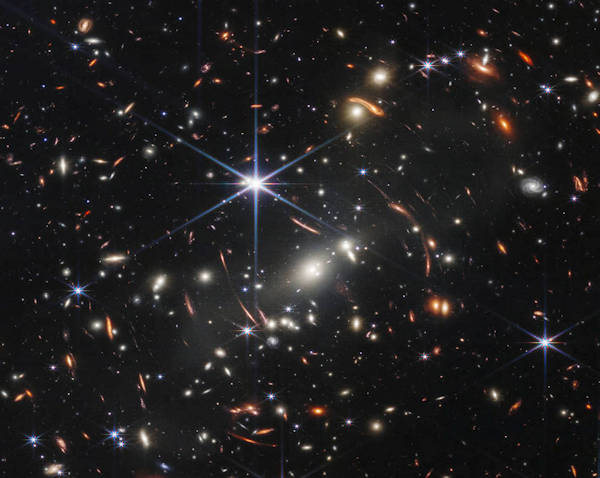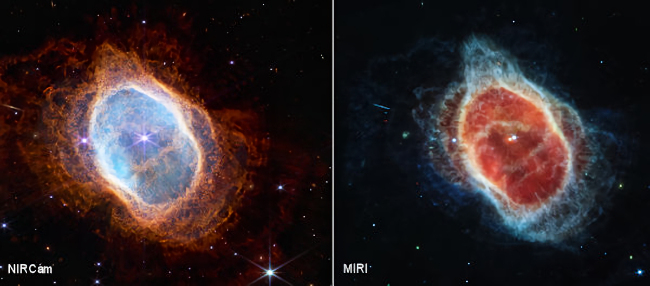Modern science, with today’s technology, has accomplished a lot in exploring the universe, but now and then something happens that reminds us we don’t know everything. In October 2023 the James Webb Space Telescope, which detects infrared light of faint objects, found some objects in Orion that were surprising. It found objects that seem to be planets but they are not orbiting stars. Actually 540 of these objects were found in Orion. But the amazing thing was that 40 of them are planet-planet binary pairs. Planets orbiting each other instead of orbiting a star. There are also two cases of trinary objects that were found in Orion, with three objects orbiting each other. They were found in a star cluster called Trapezium, which is within the Orion Nebula. The Orion Nebula is the subject of many beautiful pictures. But a nebula is a hot inhospitable place. Star clusters may be made up of hundreds to thousands of stars (such as the Pleiades for instance). In star clusters the stars are relatively close together, which means they can affect each other. So what if the stars in a star cluster have planets? This puts those planets in a kind of danger zone, a high traffic region of space.
A few definitions are in order to appreciate how unusual these objects are. There are many stars in our galaxy that have extra-solar planets orbiting them. It is generally accepted by most planetary scientists that planets form from a spinning disk of gas and dust that spins around a star that recently formed. But, it is generally accepted that when exoplanets form, they can sometimes get kicked out and escape the gravity of their star. This could happen perhaps if two planets got too close to each other. Or perhaps if an exoplanet were in a long orbit that puts it a long distance from its star and then another nearby star comes close to the planet, pulling it away. Planets that escape their stars like this are called rogue planets, or unbound planets, or sometimes FFP’s, for Free-Floating Planets. In fact the word “planet” came from a Greek word that meant “wanderer.” It can be a challenge to determine what a “free-floating” object in space is. If an object is not giving off energy like a star and it is about 14 Jupiter masses or more, it is generally called a Brown Dwarf star. It was generally believed that an object smaller than that cannot form by compression of gases and material from its own gravity. Scientists generally believed for years that it was only near a star that gas and dust could become dense enough to form planets. But today some scientists are questioning this.
The objects found in Orion have one of two new acronyms. If they are wandering alone and not orbiting any other object they are called Jupiter Mass Objects, or JMOs. If they are in pairs they are called JUMBOs, which means Jupiter Mass Binary Objects. The trinary objects don’t seem to have their own acronym. I would say to be consistent you could call them Jupiter Mass Trinary Objects, or JUMTOs. The ones found in Orion range in mass from 0.6 Jupiter mass to 14 Jupiter masses. Again, 40 of them are binary pairs. There are some amazing photos showing these planet pairs in Orion. There are a number of puzzling questions raised by these objects.
For pictures, see this article from Scientific American. Title: Stunning Images Reveal Rogue Planets of the Orion Nebula
- Why are there so many JMOs in Orion?
- Why are there so many JUMBOs in Orion?
- How did they get there?
- Did they once orbit stars, or not? If they did orbit stars, what happened to those stars?
- Could JMOs become JUMBOs? Or, could JUMBOs become JMOs?
- How stable are the JUMBOs?
The James Webb telescope detected these new objects from their heat given off in infrared energy. You might expect that if they are not orbiting a star they would be cold objects, but not usually. They are hot; they would not be detectable if they were not. Two scientists from Leiden University in the Netherlands published on the internet a technical paper describing simulations they did examining four possible scenarios that might explain the JUMBOs. The paper is not peer reviewed and is not yet published in any scientific journal as far as I can tell. The copy I found was dated March 12, 2024 (search for arXiv:2312.04645). So, this is very recent. Their last names are Zwart and Hochart. When such things are detected, if you know the distance to them you can estimate their size and mass from how bright they are. Then, for the binary ones the distance between the bound objects can be estimated. Since these objects are in a star cluster near known stars, their distances can be determined well. So Zwart and Hochart estimate that the separation distance between the binaries ranges from 25 to 380 A.U. Recall that 1 Astronomical Unit is the distance from Earth to our Sun, or about 93 million miles. Zwart and Hochart argue that these binary objects are likely to be in very elliptical orbits.
What Ifs
Zwart and Hochart look into four scenarios for where the JUMBOs came from. Note that their models do not actually handle the formation of the objects. They seem to assume they formed either around a star as conventional secular theories say, or they formed in the star cluster with the stars. For them to form around a star is the conventional notion of naturalistic formation by gravity. The second option of forming in the nebula as the stars are believed to have formed is unconventional but still naturalistic. So the computer simulations of Zwart and Hochart only look at if you start with one arrangement of stars and planets and let it run, what happens? Then if you start with a different arrangement of stars and planets and let it run again, what happens?
The four scenarios modeled in the simulations were referred to with acronyms SPP, SPM, FFC, and ISF. SPP represents Star Planet-Planet. This assumes that in the star cluster some of the stars originally form with two planets orbiting them. Then something happens causing both planets to escape the gravity of their star. Of course, this would have to have happened for at least 20 different systems to explain 40 binaries. Then there is SPM, which means Star Planet-Moon. In this case stars in the cluster form with a planet that has at least one moon. Then the planet with its moon is ejected away from the star somehow. So, in this scenario, the moon continues to orbit the planet, though the planet moves away from the star and the orbit of the moon around the planet would change. The authors pointed out that in their simulations, for this to explain the number of Jupiter Mass Objects and JUMBOs, the planet would have to start a long distance from its star as it formed (such as up to 200 A.U.), so that it would be relatively easy for the planet to be pulled away from the star. Thus, this scenario is unrealistic for explaining so many JUMBOs.
The third scenario examined by the authors was FFC, for Free-Floating Capture. In this scenario, the planets initially form from in a disk surrounding a star by the conventional concept. But, then the planets become separate from their stars later. Then the separated planets come near enough to each other to capture each other and start orbiting together. This requires two mysterious events, first something making the planets escape their star and then another chance interaction where two planets come near enough to capture each other. In this scenario, the planets start conventionally, become JMOs, then become JUMBOs. Note that this is all happening within a nebula and within a star cluster, not in empty space. The authors made the following comment about the SPP and FFC scenarios: “The SPP and FFC models systematically fail to reproduce the observed population of JuMBOs by a factor of 50 to 400.”
This leaves the ISF scenario, which represents “In situ” formation. This is where the planets are assumed to form in the star cluster in the same manner as the stars. However, in this scenario, many JUMBOs exist at the start. So many of the planets initially form as planet-planet pairs in the star cluster. How this would happen is left a mystery and not addressed by the authors of the paper. The authors also looked at what happens to the JUMBOs over time. They tend to break up and do not last long. They made the following statement about this: “Overall, the JuMBO survival rate decreases rapidly with a half-life < 1 Myr.” So after the star cluster formed, there would be many JUMBOs and the number of JUMBOs would decrease over time. Presumably some JUMBOs that separate and become JMOs could reform into binary pairs again. But the authors conclude that the ISF scenario best explains the large number of JMOs and JUMBOs. I was surprised the authors came to this conclusion.
It will be interesting to see how this is received by the scientific community. I suspect that planetary scientists will react against the authors ISF scenario because it raises difficult questions of how could planets form as binaries without a star? There is not a accepted scientific model for formation of planets like this. However, a variation on the ISF idea could be what you might call In situ Creation, or ISC. This would be to assume the binary planets were supernaturally created in the beginning with the star cluster (along with some JMOs). Then the number of JUMBOs decreases over time to the present. This would work in a young universe approach. Another possibility might involve some catastrophic scenario for the nebula or the star cluster that could explain how many planets could be pulled away from their star in a relatively short time. NASA has indicated the age of the Orion Nebula is only 2 million years. What effect would a supernova have if it were near a star cluster containing planets?
There will undoubtedly be more investigation of the possibilities to explain these surprising objects. There have been rogue planets found in other nebulas. What will the James Webb Space Telescope find in other nebulas? What other models will be put forward to explain objects like this? The density of stars in the cluster could be important in these models as well as the kind of matter in the nebula. I believe in not jumping to conclusions too quickly, as Treebeard said in Lord of the Rings, “Now now, don’t be hasty.” But I think belief in God is not undermined by new discoveries. Fortunately for us, our dear planet Earth was not placed in a star cluster like Trapezium. As we learn how to interpret the scientific evidence, new discoveries can actually validate a Biblical viewpoint.




